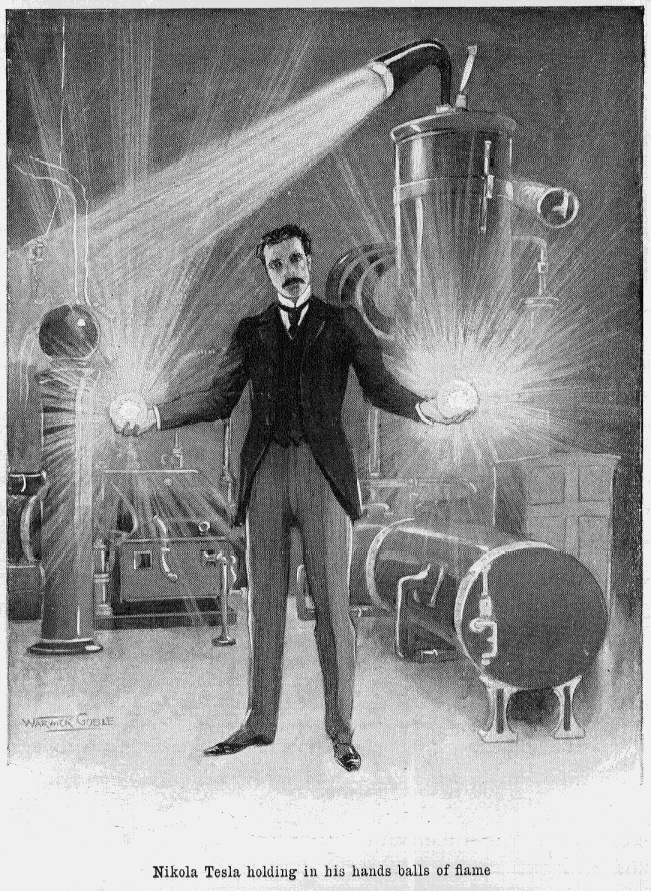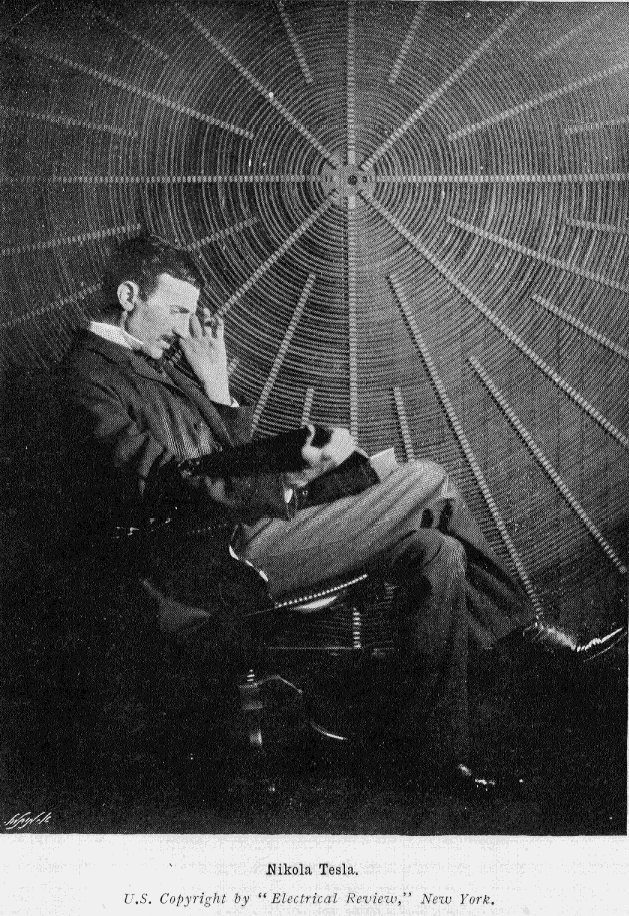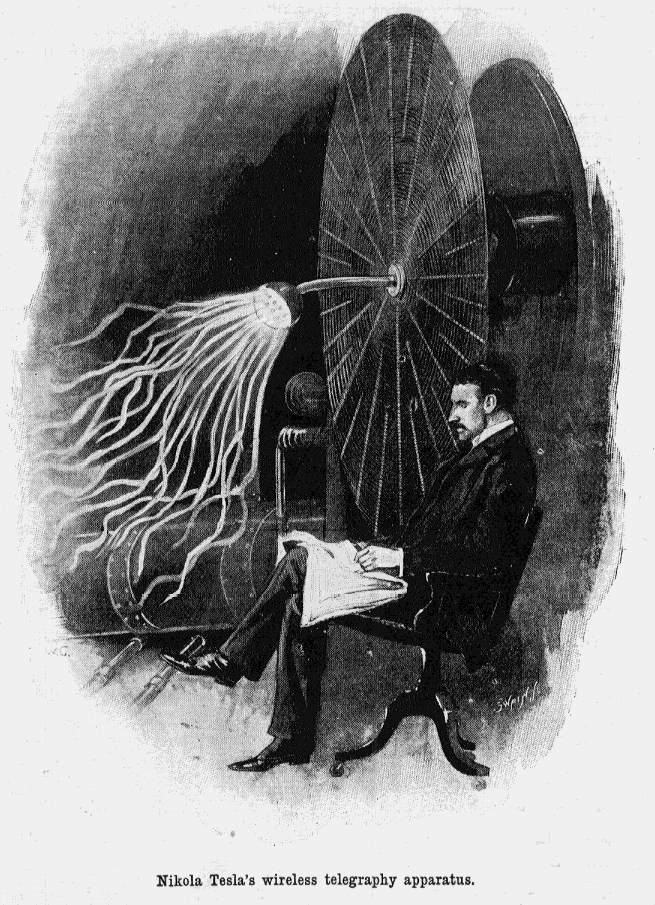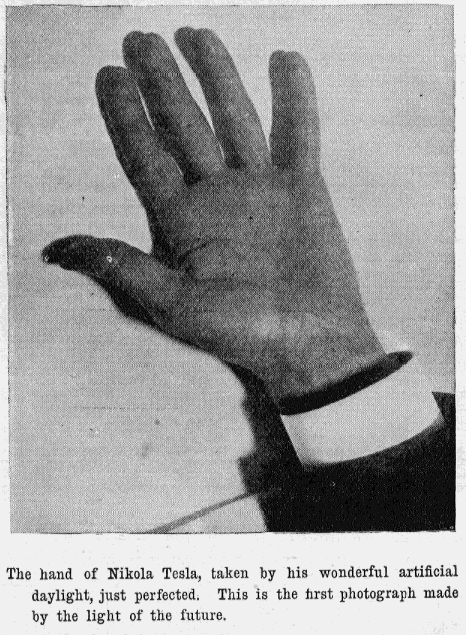The New Wizard of the West
An interview with Tesla, the Modern Miracle-Worker, who is Harnessing the Rays of the Sun, has Discovered Ways of Transmitting Power without Wires and of Seeing by Telephone; has Invented a Means of Employing Electricity as a Fertiliser; and, Finally, is Able to Manufacture Artificial Daylight.
NOT to stagger on being shown through the laboratory of Nikola Tesla requires the possession of an uncommonly sturdy mind. No person can escape a feeling of giddiness when permitted to pass into this miracle-factory and contemplate for a moment the amazing feats which this young man can accomplish by the mere turning of a hand.
Fancy yourself seated in a large, well- lighted room, with mountains of curious-looking machinery on all sides. A tall, thin young man walks up to you, and by merely snapping his fingers creates instantaneously a ball of leaping red flame, and holds it calmly in his hands. As you gaze you are surprised to see it does not burn his fingers. He lets it fall upon his clothing, on his hair, into your lap, and, finally, puts the ball of flame into a wooden box. You are amazed to see that nowhere does the flame leave the slightest trace, and you rub your eyes to make sure you are not asleep.
The odd flame having been extinguished as miraculously as it appeared, the tall, thin young man next signals to his assistants to close up all the windows. When this has been done the room is as dark as a cave. A moment later you hear the young man say in the laboured accentuation of the foreigner: ” Now, my friends, I will make for you some daylight.” Quick as a flash the whole laboratory is filled with a strange light as beautiful as that of the moon, but as strong as that of old Sol. As you glance up at the closed shutters on each window, you see that each of them is as tight as a vice, and that no rays are coming through them. Cast your eyes wherever you will you can see no trace of the source of the odd light.
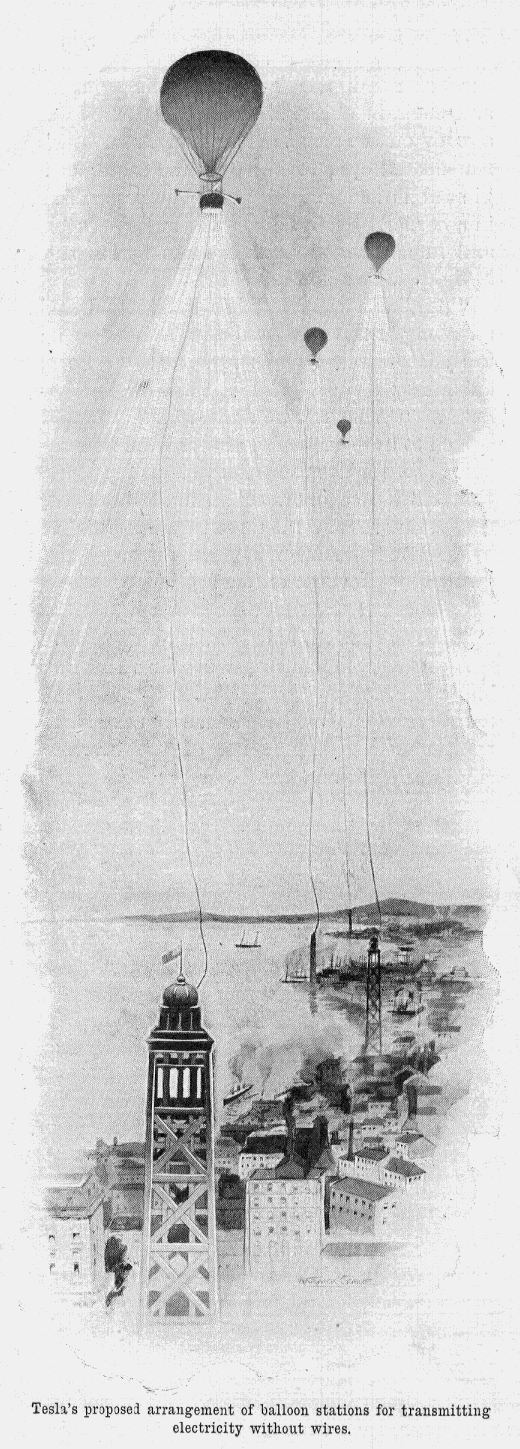 Scarcely have you begun to marvel when the light goes out by a touch on a button by the young man’s hand. The room is in darkness again until the same laboured accentuation causes the reopening of all the shutters. Some animal is now brought out from a cage, it is tied to a platform, an electric current is applied to its body and in a second the animal is dead. The tall young man calls your attention to the fact that the indicator registers only one thousand volts, and the dead animal being removed, he jumps upon the platform himself, and his assistants apply the same current to the dismay of the spectators.
Scarcely have you begun to marvel when the light goes out by a touch on a button by the young man’s hand. The room is in darkness again until the same laboured accentuation causes the reopening of all the shutters. Some animal is now brought out from a cage, it is tied to a platform, an electric current is applied to its body and in a second the animal is dead. The tall young man calls your attention to the fact that the indicator registers only one thousand volts, and the dead animal being removed, he jumps upon the platform himself, and his assistants apply the same current to the dismay of the spectators.
You feel a creeping sensation course up your back, and you see the indicator slowly mounting up to nine hundred, and then one thousand volts, and you involuntarily close your eyes, expecting the young man to fall dead before you the very next minute. But he does not budge. Quickly the indicator goes up, up, up, until presently it shows that ten thousand volts, then two million volts of electricity are pouring through the frame of the tall young man, who does not move a muscle.
At a sign, the current is stopped, the room is again made dark as night, and presently the visitor sees the sharply-defined black silhouette of the young man, with a beautiful halo of electricity in the background, formed by myriads of tongues of electric flame which are darting out from every quarter of the tall, thin frame. The place is lighted once more, and as the young man comes up to you and shakes your hand, you twist it about in the same fashion as you have seen people do who hold the handles of a strong electric battery. The young man is literally a human electric ” live wire.”
To tell of these and a thousand other wonders that Tesla does in a trice gives only a faint conception of their effect on the visitor. To really appreciate them one must see, hear, and feel them in the flesh. It is a scientific treat of a lifetime, but it is a treat that few can enjoy, for the laboratory of Tesla is securely locked against everyone not provided with an introduction from a personal friend of the audacious wizard.
“Oh, pshaw! these are only a few play- things,” Nikola Tesla replies when the visitor puts into words the astonishment he has experienced; ” none of these amount to anything–they are of no value to the great world of science. But come over here and I will show you something that will make a big revolution in every business and home as soon as I am able to get the thing into working form,” and then he leads the way through a forest of queer-looking discs and mysterious coils of copper and steel, until the party reaches a raised wall of masonry, on which reposes a long cylinder of glass filled with water, and surrounded by a circle of large mirrors. The roof over this apparatus is of glass, and as the sun pours its rays through this, the rays strike the mirrors and are reflected again towards the glass cylinder, magnifying glasses intensifying the heat of the rays before they strike the cylinder.
“This is the experimental model of the apparatus with which I hope some day to so harness the rays of the sun that heavenly body will operate every machine in our factories, propel every train and carriage in our streets, and do all the cooking in our homes, as well as furnish all the light that man may need by night as well as by day. It will, in short, replace all wood and coal as a producer of motive power and heat and electric lighting
The plan of Nikola Tesla to harness the rays of the sun to do man’s bidding is probably the boldest engineering feat that he or anyone else has ever attempted. Though the idea is so great, its principle is so simple that a schoolboy can readily comprehend it. It consists of concentrating the heat of the sun on one spot (the glass cylinder) by the series of complicated mirrors and magnifying glasses until the resulting heat is something terrific.
This manufactured heat is directed upon the cylinder filled with water. This water is chemically prepared so that in a short time the water has evaporated into steam and has passed from the cylinder through a pipe and into another chamber, In the latter place this sun-made steam is made to operate a steam-engine of ordinary construction, the horse-power of which will be determined by the size of the apparatus by which the sun generates steam in that spot. This steam-engine is used to generate electricity. And this electricity can be either used at once or else stored up in storage batteries to be used on days when there is no sunlight.
It will be seen that the object of this plan of Tesla is to do away with coal, wood, or other fuel, in the manufacture of steam. The remainder of his invention calls for the use of this sun-made steam-pressure, as steam-pressure made from coal is at present in use, throughout the world. The advantage of this Tesla invention is that the cost of manufacturing steam to generate electricity, which would propel say one hundred tram cars, would be infinitely smaller than the cost of the coal required to produce the power to do the same work. The cost of manufacturing the electricity to operate these one hundred tram cars by the Tesla plan, when once the sun station has been completed, would only be a sufficient amount to pay the salaries of a few engineers in charge of the sun-station.
“In this way electricity will be so cheapened,” says Mr. Tesla,” that it will be possible for the poorest factory-owner to use it as a power at a smaller cost than steam. Electricity will in this way supplant steam as a motive power on all railways and — in the shape of storage batteries — on all water vessels. And the humblest citizen will profit by the new system of producing electricity; for he can have it in his home to do all his cooking and lighting and heating. and it will be even cheaper for him than coal, wood, or petroleum.”
It is, of course, not the intention of Mr. Tesla that one sun-station will provide all the electricity for the whole world. His scheme is that in every city and town the local authorities shall build one or more of these sun-stations by public taxation for the use of the whole population, just as these cities now have waterworks and gas plants. Each factory and home will then get its supply of electricity from the nearest sun-station by ordinary electric wires.
Any person can appreciate the big boon that Tesla will confer on humanity by the early completion of this master task. Among other things it will solve a question that has been occupying the minds of scientific men for a long time, viz: As the supply of coal in the earth will be exhausted in about: thousand years, what are we going to do for fuel?” It was when Tesla first thought about the question that he turned his mind to the invention of some form of making power that would not depend upon coal. The plan to harness the sun’s rays is the result.
Quite independent of his scheme to harness old Sol, but yet capable of cooperation with it, is Tesla’s invention to transmit electrical power without the use of wires, this consists of a means of generating electricity in one spot, where it can be done with little cost, and transmitting the electricity to some other spot where it is impossible to generate electricity except at a big outlay of money.
Of course, it is now possible to transmit electrical power from one place to another by the use of electrical cables, but the cost of these transmitting cables is nearly as great as would be the cost of generating the electricity itself in the locality to which it is desired to transmit it. By the use of Tesla’s invention, the atmosphere takes the place of the electrical cables in the transmission of the power, and as the use of the atmosphere would be free, the cost of the transmission of electricity from one city to another would be merely nominal.
To make the atmosphere take the part of the costly cables, Tesla’s plan is to erect large power stations at every spot where a great waterfall like Niagara, for instance, makes the cost of generating electricity only trifling when the apparatus has once been constructed.
Above each of the stations Tesla wants to build a high tower, over which will be suspended a large balloon. As the electricity is generated in the station below it is conveyed by cables to the tower, and thence to the balloon, where the electricity is set free into the atmosphere. As the atmosphere at this height is much rarefied, and as Tesla has demonstrated rarefied atmosphere to be a good conductor of electricity, the electricity which is thus set free will be carried on by the atmosphere to any indefinite distance.
The second part of the Tesla plan for transmitting electrical power without wires calls for the erection of receiving stations wherever desired. These will act as sort of receivers and storage houses for the electricity set free into the atmosphere at the generating station miles away. Over each of the receiving stations will be put up a tower and a balloon, which will be equipped with the apparatus necessary to absorb the free electricity in the atmosphere and send it to the receiving station below, from which it can be sent out on wires to light the surrounding country and drive all the machinery of that particular district.
It will be observed that in this scheme Tesla depends on getting his electricity through the agency of the waterfalls, while in the previous scheme he depends upon the agency of the sun for the same purpose but the inventor is far from believing that the two schemes will conflict. He believes that when both inventions come into popular use they will work together for the common good of man. “The agency of waterfalls to generate electricity could be used when that agency is most convenient in view of natural conditions,” says Tesla, “and the agency of the sun could be used in all other cases. But my scheme of transmitting electrical energy without wires can be applied with equally good results to both systems.”
Of all the great inventions which Tesla has well on the way towards that point where they can be given to the world for every-day use, his wireless telegraphy invention is the furthest advanced, All that is necessary now is the formation of a company to put up the public station. The principle of this invention is almost too well known now to bear extended explanation. Briefly described, it consists of constructing an apparatus to stir up the electric currents in the earth in such a way that their disturbance will be felt on a second apparatus fitted up in a different part of the world. Different disturbances of the electric currents produce correspondingly different impressions on the second apparatus –the receiver–and in this way an intelligible code is readily arranged.
For the benefit of non-scientific people the great inventor has described for me his wire-less telegraphy invention in the following words:
“Imagine you have on a table before you an immense rubber bag snugly filled with water. I take a rubber tube with a piston-rod in it and insert the tube into the rubber bag. When I press on the piston-rod I compress the water in the bag so that it expands the bag.
“When I withdraw the piston,” continued Tesla, ” the bag will shrink just so much as there is water drawn up into my tube; and now if I put a second tube with a piston-rod into the bag at the other end, at every pressure of the first piston-rod the effect will be felt and measured in the second tube. Now if a certain action of one piston-rod indicates a certain word or a certain sentence, if you watch the other piston-rod carefully you may easily read it. This is exactly what takes place in wireless telegraphy,” concluded Tesla; ” let the rubber bag stand for the earth, the water for the electric currents in the earth, and the two tubes and piston-rods for a sending oscillator and receiving oscillator. One sort of disturbance by one oscillator means a certain sentence, and when this particular disturbance is recorded on the second oscillator the operator there knows exactly how to interpret it.”
The “oscillators” to which the inventor refers are huge discs on which are insulated hundreds of coils of copper wire whose ends connect with the centre of the disc, where there is a huge round copper ball. They are really the only apparatus required for wireless telegraphy. To operate them Tesla simply turns the transmitting oscillator face downwards, and turns on a current which causes immense tongues of visible electric flashes to leap from the ball into the ground. The receiving oscillator has a delicate contrivance which throbs with each disturbance of the earth’s electric currents and records them on a specially contrived apparatus.
Not the least fascinating of Tesla’s numerous inventions is one to which he has given the name of “visual telegraphy.” With this apparatus one person has only to look into the receiver of an ordinary telephone in one city, and, while talking to a friend a thousand miles away, he can watch the expression on the other’s face, criticise the cut of his new suit of clothing, or advise him what to do for that tired look about the eyes. In this invention the experimental apparatus has proved thoroughly successful. The principle of this invention is that just as much as sound-waves make an impression on the immediate atmosphere, so do light waves make their impression.
“Now, as sound waves of the human voice are transmitted miles and miles by the present telephone after their impression is made on the telephone transmitter,” says Mr. Tesla, “just so my experiments have demonstrated that the light waves of the human body can be transmitted by a different sort of telephone miles and miles away. All we need is the invention of a new transmitter. As the impressions of light waves are so many times more delicate than the impressions of sound waves, it follows that to transmit the impression of the human face, for instance, we require a transmitter many times more delicate. Now, selenium being an extremely sensitive substance, I have utilised this material in the construction of the transmitter which I have just described, and I have found it to be perfectly satisfactory.”
To make our homes, our offices, and the streets at midnight as light as day, is another of the great tasks which Mr. Tesla set out for himself many years ago. His hope was to invent a new kind of electric light which would have the strong, steady glow of sunlight.
That Tesla has succeeded in his dream to make artificial daylight there can be no doubt. To every visitor of his laboratory he shows numerous balls of glass of different sizes which look like miniature suns. The glass balls are perfectly empty, there are no wires in them, nor are there any wires on the outside of them. They do not burn the fingers when they are touched. The light does not hurt the eyes as sunlight and ordinary electric light do.
By the time this article is published, a number of the leading New York and Chicago photographers will have their studios supplied with the new artificial daylight.
“The reason I have chosen to introduce the new daylight to the photographers first,” says the inventor, ” is that I believe them to be the severest critics, and most hard to please in the matter of light. If it succeeds with them, a new light will succeed everywhere.”
Not the least ingenious of Tesla’s great schemes is his invention to fertilise impoverished land by electricity. When Tesla has a company formed to put this invention on the market it will no longer be necessary for the farmer to spend half his year’s receipts in purchasing fertilisers. He has only to buy an electric fertiliser of his own, which he can secure for a trifle at the nearest town.
Dumping a few loads of loose earth into the fertiliser, it comes out at the other end, ready to be spread over the surface of the impoverished ground, where it will insure for the following season the luxurious crop of the virgin soil.
The explanation which Mr. Tesla gives of just why so simple a piece of work should be productive of such wonderful results is not difficult to comprehend. ” Everyone knows,” says he, ” that the constituent of a fertiliser which makes the ground productive is its nitrogen. Everybody knows also that nitrogen forms four-fifths of the volume of the atmosphere above that piece of unfertile land. This being the case it occurred to me: ‘Where is the sense in the farmer buying expensive nitrogen when he has it free of cost at his own door? All the agriculturist needs is some method by which he can separate some of this nitrogen from the atmosphere above the ground and place it on the surface.’ And it was to discover this means that I set to work.”
As far as the non-technical eye can perceive, the working model of the electric fertiliser consists of nothing but an upright copper cylinder with a removable top, with a spiral coil of wire running throughout the length of the cylinder. Through the bottom of the cylinder are two wires, which connect with a specially constructed dynamo. A quantity of loose earth, treated by a secret chemical preparation in liquid form, is shoveled into the cylinder, an electric current is passed through the confined atmosphere; the oxygen and hydrogen are thus expelled, and the nitrogen which remains is absorbed into the loose earth. There is thus produced as strong a fertiliser for a nominal price at home as it is possible to purchase at a large cost miles and miles away.
Mention is made in this paper of only those inventions of Mr. Tesla which have passed beyond the experimental stage. But there are hundreds of other promised wonders in the yet incipient stage of development in the great inventor’s miracle-factory. As I have heard one of his admirers express it, an enumeration of these ” sounds like the dream of a half-intoxicated god.” Signaling to other planets, raising of certain of the dead by electricity, ending all wars by a terrible machine — these are a few suggestions selected at random.
Nikola Tesla is a young man yet, and on this account many of his promises have been looked upon by older scientists as but fanciful dreams of a youthful mind. He has scarcely ever made any invention which the scientific world has accepted as possible on the first public announcement. But sooner or later the scientific wiseacres have been compelled to admit that Tesla has proven their theories to be wrong.
How these conservative scientists sneered at Tesla’s “Utopian audacity” when he first suggested that man should harness the great Niagara Falls! But they humbled their pride sufficiently to be present when the enterprise was formally completed. Again, when he announced the invention of the “Tesla coil” they set him down as “pipe-dreamer.” But a few of the brightest of them set to work seriously on the “coil” with the result that one of them — Roentgen — discovered his famous X-Rays. No one who is privileged to know Tesla personally, to have heard him explain his plans, and to have been shown through his unique workshop, has the slightest doubt that every one of his promises will be fulfilled in an equally successful way.

